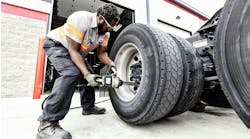Most fleets today take a preventive approach to maintenance — pulling a truck off the road for scheduled service based on a predetermined number of miles or hours in operation. If a problem is not caught in time, what started as a minor issue can rapidly snowball into a more expensive repair that forces a vehicle out of service for an extended length of time.
For the trucking industry, connectivity, machine learning, and artificial intelligence technologies are now capable of revolutionizing maintenance practices. Predictive maintenance shifts the focus to data-driven decisions. Instead of repairing a truck as something breaks, data can help spot and fix a potentially weak link in advance.
With the aid of real-time telematics data and analytics, fleets can begin to shift to a predictive maintenance program from the reactive or preventive plans that are commonplace today.
Read more: Four ways for fleet managers to avoid data overloadKnow your data
For many fleets, new technologies can be a double-edged sword, with the excitement of unlocking savings and boosting productivity giving way to the reality of information overload.
So, while the transition to predictive maintenance can boost vehicle utilization and driver satisfaction by identifying emerging problems before they become larger headaches, the data generated from the countless IoT sensors being added to the rapidly growing number of connected trucks can quickly overwhelm fleets.
While the data from each IoT sensor can be used to positively impact fleet maintenance, their respective benefits are far from equal when focusing on the frequency and severity of component failures.
Getting started with predictive maintenance
It can be difficult to navigate how best to get started with a predictive maintenance program.
The best first step is to consider the equipment that not only carries a high maintenance burden, but also causes the greatest damage when it fails. To take a cue from the insurance industry, trucking can benefit by first focusing on “high-severity and high-frequency” incidents; those that are almost certain to occur and would be more likely to have devastating outcomes when they happen.
Read more: How predictive maintenance can save fleets a fortuneWhen considering these factors, it becomes clear that tires are the logical choice for an IoT-related investment.
Underinflated tires foreshadow premature tire wear, tire failure, or even a tire-related accident in the future. That can be seen in statistics from the National Highway Traffic Safety Administration (NHTSA), which show 35% of accidents attributed to “vehicle malfunctions” are primarily attributed to tire-related problems.
The main reason behind this troubling figure is how significant a problem tire underinflation is throughout the industry. Studies by the American Trucking Associations’ Technology & Maintenance Council (TMC) found that one out of five commercial vehicles is operating with one or more tires underinflated by at least 20 psi and that only 46% of all tractor tires and 38% of all trailer tires are within plus or minus 5 psi of the target pressure.
TMC recommends that any tire found to be inflated to less than 80% of target pressure should be inspected, and that a tire underinflated by 50% or more should be considered flat and taken out of service.
Even a single underinflated tire could lead to a sudden blowout, preventing the driver from completing a safe, on-time delivery. The downtime caused by an emergency road call could lead to additional delays and lost revenue.
Predictive maintenance and tires
Tires need to be checked and maintained more than any other component on a truck and therefore stand to disproportionately benefit from the addition of automation paired with sensors and analytics.
Predictive tire maintenance tools, such as Halo Connect from Aperia Technologies, leverage machine learning to assess countless variables such as geography, temperature, and pressure profile to diagnose and categorize tire issues by severity, which assists in cost-effective maintenance planning. Data is continually captured by the system and compared with historical markers to recognize tire damage accumulated, spot early warning signs of potential failures, and plan the right time for maintenance.
With each mile, the predictive analytics of the system gets smarter. These features enable fleet managers to confidently make decisions about where and when to service tires, minimizing disruptions and maximizing equipment utilization. By coupling active inflation with machine learning, fleets utilizing Halo Connect are trimming unplanned, tire-related downtime by an estimated 90%. The result is a decrease in on-road breakdowns, reduced technician diagnostic time, and increased automation of routine tasks.
By constantly managing tire pressure and alerting when tire health is jeopardized, this technology can eliminate human error and simplifies processes for drivers and other employees alike. It extends the lifespan of tires by reducing wear and tear from underinflation while improving overall driving performance and fuel efficiency by ensuring optimal pressure.
If a more serious issue is likely to occur, the system notifies maintenance personnel to begin preparations for a repair process that will minimize downtime and help technicians focus on the highest-priority repair work.
With tools such as Halo Connect, fleets no longer rely on time intervals and historical assumptions, and tire maintenance shifts to a predictive model based on specific data and actual utilization.
Unlike other truck systems, the technology capable of transforming fleet tire maintenance is mature and available now. The savings and intelligence enabled by these digital tools will build a predictive maintenance foundation that larger investments in IoT and predictive maintenance practices can build on as they mature in the future.



